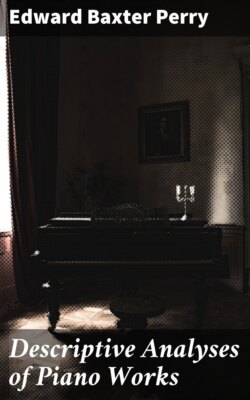Читать книгу Descriptive Analyses of Piano Works - Edward Baxter Perry - Страница 12
На сайте Литреса книга снята с продажи.
Beethoven: Sonata, E Minor, Op. 90
ОглавлениеTable of Contents
This composition is one of the shortest, easiest, and, from the standpoint of magnitude, least important of Beethoven’s later works. It has but two movements, neither of them of extreme technical difficulty, and in structure it fails, in various essential respects, to fulfil the requirements of the conventional sonata form. Indeed, the same may be said of many of his best known and most played sonatas, which are sonatas only in name, according to the generally accepted technical significance of the term, notably the Op. 26, Op. 27, No. 2, and others. Yet this little Op. 90, in E minor, is among his most genial, interesting, and gratefully musical compositions. In spite of an occasional touch of pedantry, it is full of melodic charm and emotional suggestiveness. It is not descriptive in the sense of portraying either actual scenes or events. It deals not with action, but with a series of varying, strongly contrasted moods.
It is dedicated to Count Lichnowsky, a resident of Vienna, with whom the composer was intimately acquainted, and of whose touching little love story it is a musical embodiment. The Count’s personal experiences of mind and heart suggested the work and formed its emotional content. He was a member of one of the most aristocratic Viennese families, belonged to the highest nobility, and had inherited a proud old name and vast estates. He occupied a lofty position in both social and diplomatic circles, but he had become seriously and profoundly attached to a young actress of unquestioned talent and rising fame, but of obscure and very humble origin—a girl of exceptional beauty, sterling character, and refined, winning personality, but, considered from the standpoint of worldly position and class traditions, a wholly unsuitable alliance for the great noble.
It is difficult for one educated in democratic America to grasp the conditions involved in such a situation, or to understand and to sympathize with the painful struggle in the mind of the Count, the maddening doubts, the heart-sick vacillation on her account, as much as his own, before the final decision was reached; the obstacles to be overcome, the opposition of friends and relatives to be met or defied, before the path could be cleared to his desired goal. On the one hand, love and happiness with the woman of his choice; on the other, social ostracism for his future wife, certainly, and for himself, probably; serious detriment to his promising career; a life of constant battle with class prejudice, of incessant petty slights and mortifications; a position necessarily trying and humiliating to both. At last, however, love triumphed over all doubts and difficulties, as it always should and must if genuine, and the wedding took place.
It is said, “All the world loves a lover,” and certainly the story of true love victorious over all opposition is the oldest and to most people the most interesting ever told. This story, or at least the emotions underlying it, expressed in music, Beethoven gives us in the two strongly contrasted movements of this little sonata: a simple drama of hearts, in two acts, written in the language of tone.
The first movement deals with the period of doubt and indecision, of mental conflict and moody alternation, of resolve and depression. Its strong, passionate minor first subject in chords expresses the struggle and unrest, the indignant protest against petty prejudice and inflexible conventionality; while its plaintive little counter-theme tells of tender longings, of sad discouragements, of hopes deferred and desire thwarted. In the development it reaches a vigorous, rough, almost dissonant climax, as of bitter defiance and fierce scorn of the world and its trammels.
The second movement, calm, fluent, and sweetly melodious, full of rest and tranquil content, deals with the period after love’s victory, when hope has been fulfilled and the heart’s unrest has been transformed to peace and happiness, where life flows onward like a placid stream, its waters brightened and purified by the glad sunlight of perfect love and full-orbed happiness, its waves murmuring the old yet ever new refrain, the simple, natural, yet magically potent melody, to which the symphony of the universe is harmonized.
There is an occasional brief suggestion of past strife and remembered trial, just sufficient to give enduring zest to the present, reposeful joy; but, as a whole, this last movement, with its constantly reiterated tender yet cheerful major melody, seems to sing over and over, with trifling variations of form, but untiring delight in its essential burden, the song of love’s completeness. A song without words it may be, but with a meaning passing words.
